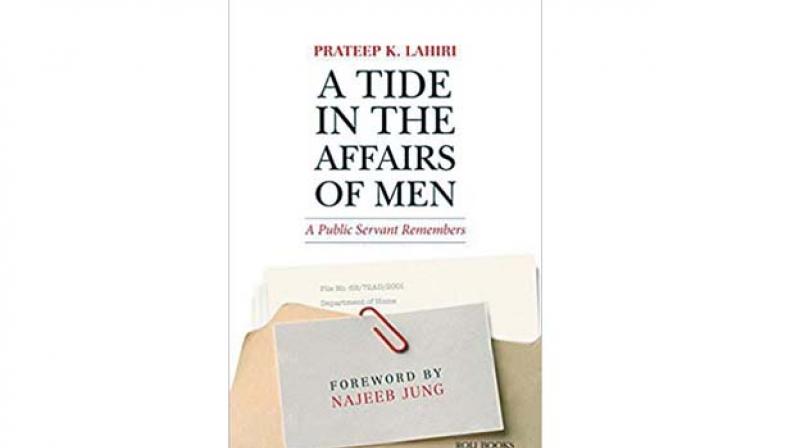A babu's insider view, warts and all

Memoirs by Indian bureaucrats rarely give one a candid insider’s view about their years in government, although many continue to offer gratuitous advice to the government through newspaper columns after they retire. Generals, policemen and spy chiefs impalusibly transform into peaceniks and supporters of civil liberties in their search for new constituencies and post-retirement jobs.
Those governed do not know how they are really governed. They teeter between the view that the Indian bureaucracy is still the steel frame, though somewhat ramshackle, that holds the State together and the idea, formed by their own interactions with bureaucrats, that they are inefficient, corrupt and mostly interested in self-promotion.
It is a pleasure therefore to come across reminiscences such as A Tide in the Affairs of Men, where a bureaucrat attempts to describe his life in government, warts and all.
The early chapters of the book where the writer describes his experiences as a young civil servant still wet around the ears, give us fascinating insights into the ungovernability of situations on the ground. There is a lovely story from the days of shortages when the delay in granting a permit for 50 kg of sugar from a fair price shop to a Sikh gurdwara in Katni for a “langar” spiralled out of control. It led to a strike by shopkeepers and ultimately other gurdwaras, and even the Akal Takht got involved.
The situation was resolved after the district magistrate advised young Lahiri to arrange for the sugar the first thing in the morning and offer an apology to the gurdwara even though he himself had done nothing wrong and it was a minor official who was at fault.
Lahiri learns other valuable lessons in administration when he tries to prevent starvation deaths due to a famine situation by illegally diverting a trainload of food meant for another district. However, it is his observations from the ground about how Hindu-Muslim communal riots are organised that are quite revealing. They remain true even today.
After his experience of communal riots in Jabalpur and Indore, Lahiri gains several important insights. He notes that often an individual dispute between members of the two communities is used to trigger a bigger conflict and that local media plays a role in creating disaffection among the people. He recounts the mischievous role played in the Indore riots of 1969 by newspapers affiliated to right-wing Hindu orgnaisations Swadesh, Dainik Kiran and Saptahik Matribhoomi. The resultant communal polarisation is then used by them to garner votes.
The author urges that the administration must err on the side of caution and seek the assistance of the Army well in time, as he did in Indore. He underlines the consequences of failure to do so in the anti-Sikh riots of 1984 in Delhi, 1992-93 in mUMBAI and 2002 in Gujarat.
The book laments the erosion of the political culture of the first generation of leaders of Independent India and argues that by 1970 unbridled corruption marked the polity. However, he notes approvingly the proactive positions taken by institutions like the Comptroller and Auditor-General (CAG) of India, the Central Vigilance Commission and the Central Bureau of Investigation (CBI) in holding corrupt officials to account. This is far too bland a claim unless one discusses how and on whose behalf these institutions have acted.
Lahiri stays shy of passing judgment, for example, on the estimate of the so-called “presumptive losses” in the 2G spectrum allocation by a recent CAG. He merely distances himself from the CAG’s findings by quoting another incumbent to the post that perhaps an estimate of the recoverable losses should also have been given along with presumptive losses.
Let us recall that CBI special court judge O.P. Saini had said about presumptive losses that it was a scam created “by artfully arranging a few selected facts and exaggerating things beyond recognition to astronomical levels”. The judge also described the CBI chargesheet as “well-choreographed”. If the institutions that could make governance accountable have become like dogs with bones in their mouth who can neither bark nor bite, one hopes that an insider will eventually speak up. As it stands, corruption in high places have little chance of being exposed unless it is “outed” for political vendetta.
The author provides a pen-portrait of Dr Manmohan Singh as finance minister in the P.V. Narasimha Rao government and later as Prime Minister. From his experience of working closely with him, the author endorses him as an honest and upright man but suggests that even gods have feet of clay. Lahiri mentions an incident when as India’s director at the Asian Development Bank he was under pressure from finance minister Singh to recruit the daughter of a woman journalist with access to Narasimha Rao. In another instance he was expected to facilitate the promotion of an Indian staffer of the ADB, who was the son of a prominent public figure in India, and, the author suggests, Dr Singh’s friend.
If for these two misdemeanours, Dr Manmohan Singh is to be condemned, then let the bureaucrat who has never sought a favour for his kin or bestowed favours under pressure, throw the first stone.
Overall, the book is a racy read, faltering occasionally when the writer starts using charts and tables to discuss coal nationalisation or details of how diamonds are formed, drowning policy lessons in the details.
It is a bit disconcerting when the bureaucrat gets his details wrong. In defending the controversial Tehri Dam, the author says that the dam helped to impound the swelling waters of the Bhagirathi in 2013, thereby saving Rishikesh and Hardwar from the Kedarnath floods of that year. The blooper is that the Kedarnath floods were caused by a local lake-burst affecting the Mandakini river and its tributaries. The catchment area of the Tehri dam lies in the completely different valley of the Bhagirathi.
The writer is a journalist based in New Delhi

